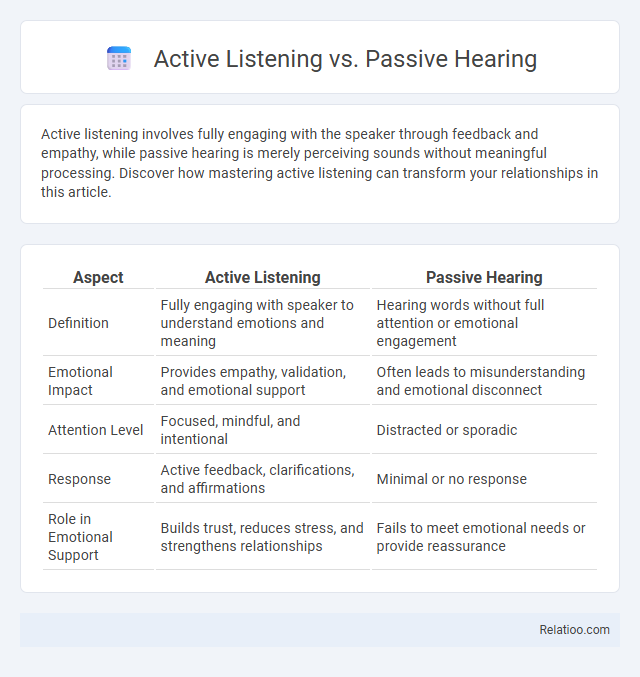Active listening involves fully engaging with the speaker through feedback and empathy, while passive hearing is merely perceiving sounds without meaningful processing. Discover how mastering active listening can transform your relationships in this article.
Table of Comparison
| Aspect | Active Listening | Passive Hearing |
|---|---|---|
| Definition | Fully engaging with speaker to understand emotions and meaning | Hearing words without full attention or emotional engagement |
| Emotional Impact | Provides empathy, validation, and emotional support | Often leads to misunderstanding and emotional disconnect |
| Attention Level | Focused, mindful, and intentional | Distracted or sporadic |
| Response | Active feedback, clarifications, and affirmations | Minimal or no response |
| Role in Emotional Support | Builds trust, reduces stress, and strengthens relationships | Fails to meet emotional needs or provide reassurance |
Understanding Active Listening and Passive Hearing
Active listening involves fully engaging with the speaker through focused attention, feedback, and interpretation to accurately comprehend the message. Passive hearing, on the other hand, is a subconscious process where sounds are perceived without deliberate processing or understanding. Respectfulness enhances active listening by fostering an open, non-judgmental environment that facilitates meaningful communication and deeper understanding.
Key Differences Between Active Listening and Passive Hearing
Active listening requires full attention, engagement, and feedback to understand the speaker's message, while passive hearing involves merely perceiving sounds without processing or responding to the information. Respectfulness in communication is demonstrated by active listening, showing that you value the speaker's perspective, whereas passive hearing often lacks this level of acknowledgment. Your ability to practice active listening enhances relationships by fostering trust and clearer understanding, distinguishing it fundamentally from passive hearing.
The Science Behind Active Listening
Active listening engages your brain in processing and interpreting verbal and nonverbal cues, enhancing understanding and memory retention. Neuroscientific studies reveal that active listening activates areas in the prefrontal cortex related to attention and empathy, distinguishing it from passive hearing, which involves minimal cognitive effort. Respectfulness during communication fosters a supportive environment where active listening can thrive, promoting deeper connections and effective information exchange.
Common Traits of Passive Hearing
Passive hearing involves perceiving sounds without engaging in conscious processing or interpretation, characterized by a lack of attention and minimal cognitive involvement. Individuals exhibiting passive hearing often miss contextual cues and emotional nuances, leading to misunderstandings or overlooked information. Unlike active listening or respectfulness, passive hearing does not foster meaningful communication or connection, as it fails to demonstrate empathy or intentional focus on the speaker's message.
Benefits of Practicing Active Listening
Active listening enhances communication by fully engaging your attention, leading to improved understanding and stronger relationships. Unlike passive hearing, which involves simply perceiving sounds without processing, active listening helps you respond thoughtfully and accurately. Practicing respectfulness through active listening demonstrates empathy, fosters trust, and reduces misunderstandings in both personal and professional interactions.
Drawbacks of Relying on Passive Hearing
Relying on passive hearing limits comprehension and retention as it involves merely perceiving sound without processing or understanding the message. This approach often leads to misunderstandings, missed details, and ineffective communication, as important nuances and emotions are overlooked. In contrast, active listening engages cognitive faculties, promoting clarity and respectfulness by validating the speaker's perspective and fostering meaningful interaction.
Techniques to Develop Active Listening Skills
Developing active listening skills involves techniques such as maintaining eye contact, providing verbal and non-verbal feedback, and avoiding interruptions to fully engage with the speaker. Paraphrasing or summarizing the speaker's points ensures accurate understanding and demonstrates attentiveness. Respectfulness in communication enhances active listening by fostering an open, empathetic environment where the listener values the speaker's perspective without judgment.
Barriers to Effective Listening and How to Overcome Them
Barriers to effective listening include distractions, preconceived notions, and emotional biases that hinder active listening, which requires full engagement and comprehension, unlike passive hearing that involves merely perceiving sound without processing meaning. Respectfulness enhances active listening by fostering an open, non-judgmental environment that encourages sincere communication and reduces misunderstandings. Overcoming these barriers involves minimizing external distractions, cultivating empathy and openness, and consciously practicing attentive feedback to ensure accurate understanding and stronger interpersonal connections.
Real-Life Scenarios: Active Listening vs Passive Hearing
Active listening in real-life scenarios involves fully engaging with the speaker by providing feedback, asking clarifying questions, and acknowledging emotions, which strengthens communication and trust. In contrast, passive hearing occurs when one only perceives the sound without processing or responding thoughtfully, leading to misunderstandings and weakened relationships. Respectfulness enhances active listening by creating a supportive environment where individuals feel valued and understood, promoting effective interpersonal connections.
Enhancing Communication Through Active Listening
Active listening significantly enhances communication by fully engaging with the speaker, interpreting both verbal and non-verbal cues, and providing thoughtful feedback, which contrasts sharply with passive hearing that involves merely perceiving sounds without processing or responding to the message. Respectfulness in conversation fosters trust and openness, creating a supportive environment where active listening can thrive and misunderstandings are minimized. Cultivating active listening skills leads to clearer understanding, stronger relationships, and more effective problem-solving in personal and professional interactions.

Infographic: Active Listening vs Passive Hearing
 relatioo.com
relatioo.com